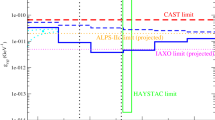Abstract
Particle physicists and cosmologists have sought axion-like particles (ALPs) ever since they were postulated in quantum chromodynamics and string theory. We propose probing the electromagnetic interaction between ALPs and photons using the inter-conversion of cosmic microwave background (CMB) photons and ALPS in the magnetic field of galaxy clusters. Importantly, the unique, polarized non-gravitational signature of ALPs we propose can be measured from high resolution CMB imaging experiments even if ALPs are not the dark matter; our approach is therefore directly competitive with laboratory experiments. The search for this signal from the large sample of galaxy clusters from the upcoming CMB missions can provide orders of magnitude better constraints on the coupling between photons and ALPs than the current bounds available from any experiments. The ALP mass range and couplings that will be probed by the CMB experiments are unexplored to date and complementary with other cosmological searches from the imprints of ALPs on the cosmic density field.



Similar content being viewed by others
REFERENCES
R. D. Peccei and H. R. Quinn, Phys. Rev. Lett. 38, 1440 (1977).
S. Weinberg, Phys. Rev. Lett. 40, 223 (1978).
F. Wilczek, Phys. Rev. Lett. 40, 279 (1978).
P. Svrcek and E. Witten, J. High Energy Phys. 06, 051 (2006); hep-th/0605206.
A. Arvanitaki et al., Phys. Rev. D 81, 123530 (2010); arXiv: 0905.4720.
J. Ruz, J. K. Vogel, and M. J. Pivovaroff, Phys. Proc. 61, 153 (2015).
N. Bastidon (for the ALPS Collab.), arXiv: 1509.02070 (2015).
B. Majorovits et al. (2016); arXiv: 1611.04549.
S. J. Asztalos et al., Phys. Rev. Lett. 104, 041301 (2010); arXiv: 0910.5914.
D. Budker et al., Phys. Rev. X 4, 021030 (2014); arXiv: 1306.6089.
W. Hu, R. Barkana, and A. Gruzinov, Phys. Rev. Lett. 85, 1158 (2000); astro-ph/0003365.
R. Hlozek, D. Grin, D. J. E. Marsh, and P. G. Ferreira, Phys. Rev. D 91, 103512 (2015); arXiv: 1410.2896.
P. Sikivie, Phys. Rev. Lett. 51, 1415 (1983).
G. Raffelt and L. Stodolsky, Phys. Rev. D 37, 1237 (1988).
S. Mukherjee, R. Khatri, and B. D. Wandelt, J. Cosmol. Astropart. Phys. 1804, 045 (2018); arXiv: 1801.09701.
S. Mukherjee, D. N. Spergel, R. Khatri, and B. D. Wan-delt, J. Cosmol. Astropart. Phys. 2002, 032 (2020); arXiv: 1908.07534.
S. Mukherjee, R. Khatri, and B. D. Wandelt, J. Cosmol. Astropart. Phys. 1906, 031 (2019); arXiv: 1811.11177.
G. G. Raffelt, Stars as Laboratories for Fundamental Physics (Univ. Chicago Press, Chicago, 1996).
L. D. Landau, Phys. Zeitschr. Sowjetunion 2, 46 (1932).
C. Zener, Proc. R. Soc. London, Ser. A 137, 696 (1932).
F. Govoni and L. Feretti, Int. J. Mod. Phys. D 13, 1549 (2004); astro-ph/0410182.
T. E. Clarke, P. P. Kronberg, and H. Bohringer, Astrophys. J. Lett. 547, L111 (2001). http://stacks.iop.org/1538-4357/547/i=2/a=L111.
I. Bartalucci, M. Arnaud, G. W. Pratt, A. Vikhlinin, E. Pointecouteau, W. R. Forman, C. Jones, P. Mazzotta, and F. Andrade-Santos, Astron. Astrophys. 608, A88 (2017); arXiv: 1709.06570.
H. Bohringer, G. Chon, and P. P. Kronberg, Astron. Astrophys. 596, A22 (2016); arXiv: 1610.02887.
P. Ade et al. (Simons Observatory Collab.) arXiv: 1808.07445 (2018).
K. N. Abazajian et al. (CMB-S4 Collab.); arXiv: 1610.02743 (2016).
M. Tegmark and G. Efstathiou, Mon. Not. R. Astron. Soc. 281, 1297 (1996); astro-ph/9507009.
V. Anastassopoulos et al. (CAST), Nat. Phys. 13, 584 (2017); arXiv: 1705.02290.
A. Payez, C. Evoli, T. Fischer, M. Giannotti, A. Mirizzi, and A. Ringwald, J. Cosmol. Astropart. Phys. 2, 006 (2015); arXiv: 1410.3747.
J. P. Conlon, M. C. D. Marsh, and A. J. Powell, Phys. Rev. D 93, 123526 (2016); arXiv: 1509.06748.
B. Thorne, J. Dunkley, D. Alonso, and S. Naess, Mon. Not. R. Astron. Soc. 469, 2821 (2017); arXiv: 1608.02841.
F. Pérez and B. E. Granger, Comput. Sci. Eng. 9, 21 (2007). http://ipython.org.
J. D. Hunter, Comput. Sci. Eng. 9, 90 (2007).
S. van der Walt, S. C. Colbert, and G. Varoquaux, Comput. Sci. Eng. 13, 22 (2011); arXiv: 1102.1523.
ACKNOWLEDGMENTS
S.M. acknowledges David Spergel, Rishi Khatri, and Benjamin Wandelt for crucial contributions on the paper [16] in which this idea was proposed. SM thanks David Spergel for reading the initial draft of this manuscript and also Lyman Page, and Neelima Sehgal for useful discussions on the work. We acknowledge the use of the following packages PySM [31], IPython [32], Matplotlib [33], and NumPy [34] in this analysis. This analysis is carried out at the Horizon cluster hosted by Institut d’Astrophysique de Paris. We thank Stephane Rouberol for smoothly running the Horizon cluster.
Funding
S.M. is supported by the DITP fellowship. This work is part of the Delta ITP consortium, a program of the Netherlands Organisation for Scientific Research (NWO) that is funded by the Dutch Ministry of Education, Culture, and Science (OCW).
Author information
Authors and Affiliations
Corresponding author
Additional information
Paper presented at the Fourth Zeldovich meeting, an international conference in honor of Ya.B. Zeldovich held in Minsk, Belarus, on September 7–11, 2020. Published by the recommendation of the special editors: S.Ya. Kilin, R. Ruffini, and G.V. Vereshchagin.
Rights and permissions
About this article
Cite this article
Mukherjee, S. Discovering Axion-Like Particles Using Cosmic Microwave Background as the Backlight. Astron. Rep. 65, 995–1001 (2021). https://doi.org/10.1134/S1063772921100243
Received:
Revised:
Accepted:
Published:
Issue Date:
DOI: https://doi.org/10.1134/S1063772921100243



